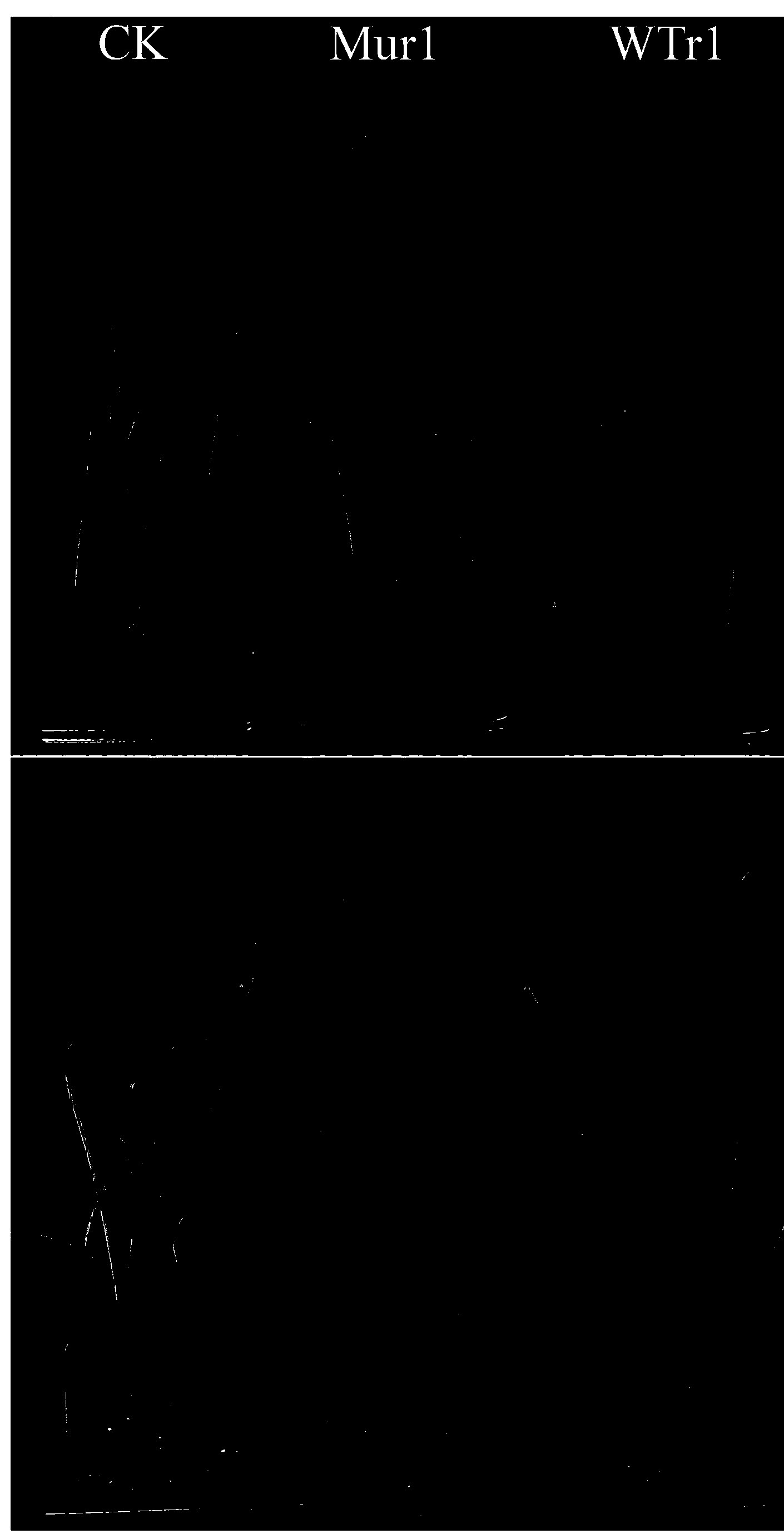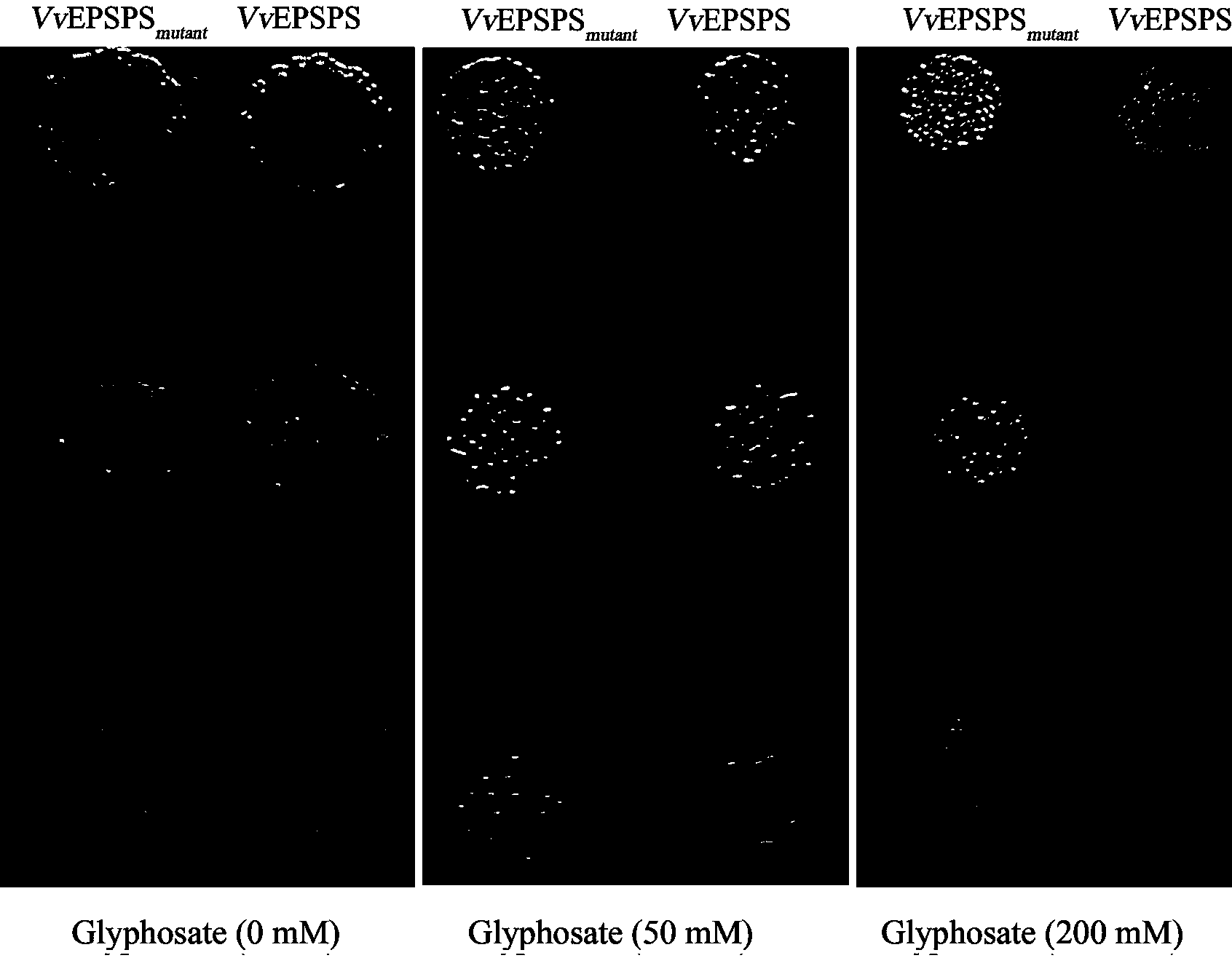Preparation of glyphosate resistance enhanced EPSPS (5-enolpyruvyl shikimate-3-phosphate synthase) mutant of Vitis vinifera and application of EPSPS mutant of Vitis vinifera
A technology of EPSP synthase and grape, which is applied in the fields of application, botany equipment and methods, biochemical equipment and methods, etc., and can solve the problems of non-transgenic crop cultivation and so on
- Summary
- Abstract
- Description
- Claims
- Application Information
AI Technical Summary
Problems solved by technology
Method used
Image
Examples
Embodiment 1
[0019] Example 1 DNA molecular rearrangement (DNA Shuffling) of EPSP synthase gene
[0020] 1.1 Glyphosate herbicide resistance genes derived from grapes VvEPSPPS Synthesis
[0021] The applicant entered 5-enolpyruvylshikimate-3-phosphate synthase and Vitis vinifera on the NCBI website (http: / / www.ncbi.nlm.nih.gov), and obtained the coded grape 5-enolpyruvyl-shikimate with the serial number NM_001281247 - The mRNA sequence of the 3-phosphate synthase gene. Design a pair of PCR primers according to this sequence (VvEPSPSZ: 5'-AAGGATCCATGGCCTCTGTCGCCACTAAG
[0022] -3' and VvEPSPSF: 5'-AAGAGCTCTCAATGTTTGGTAAAACGCTGG-3'), using the Kyoho grape cDNA library preserved in this experiment (Northwest Botanical Journal, 2009, 29:1723-1729) as a template, the grape EPSP synthase was amplified by RT-PCR Gene( Vv EPSPS) full-length cDNA sequence. Reaction system: 1μl cDNA + 4μl 2.5mmol / L dNTPs + 25μl Buffer + KOD Plus (Toyobo Japan) polymerase 1U + 1μl VvEPSPSZ + 1μl VvEPSPSF +ddH ...
Embodiment 2
[0032] Example 2 Screening and sequence analysis of high glyphosate-resistant EPSP synthase mutants
[0033] 2.1 Screening of high glyphosate-resistant EPSP synthase mutants
[0034] The above-mentioned recovered and rearranged EPSP synthase gene fragment was digested with BamH I and Sac I, and then constructed into the prokaryotic expression vector pG251 (CN1338515) between the promoter and the t1t2 terminator, which carries the ampicillin resistance gene. Transform Escherichia coli strain DH5α by electroporation to obtain mutant expression library with a capacity of 10 8 , and then use a large number of plasmid extraction kits (Omega, USA) for plasmid extraction.
[0035] Take 1 μl of a large amount of extracted plasmid and transfer it into Escherichia coli ER2799 (NEB Company) and spread it on an M9 plate containing 200mM glyphosate for 48 hours. It was found that a colony grew well. The plasmid extracted from the clone (pVvEPSPS mutant ) into Escherichia coli ER2799 (NE...
Embodiment 3
[0038] Example 3 In vitro glyphosate resistance test
[0039] The wild type obtained in embodiment 1 VvEPSPPS After the gene was digested with BamH I and Sac I, it was constructed into the prokaryotic expression vector pG251 to obtain the plasmid pVvEPSPS. Transform the pVvEPSPS plasmid and the pVvEPSPS obtained in Example 2 respectively with Escherichia coli ER2799 bacterial strain mutant Plasmids were spread on M9 plates and cultured for 48 hours, and the respective transformants were picked out with toothpicks and inoculated in LB liquid medium for culture until the concentration reached 5 × 10 3 cells / μL, take 2μL of the respective cell fluids and 1 / 5 and 1 / 25 diluted cell fluids and spot them on M9 plates containing different concentrations of glyphosate (0, 50mM, 200mM), and observe after 48 hours of culture 50mM glyphosate has basically inhibited wild-type VvEPSPPS cell growth. However, when the concentration of glyphosate was 200mM, the mutant VvEPSPS mutant C...
PUM
 Login to View More
Login to View More Abstract
Description
Claims
Application Information
 Login to View More
Login to View More - R&D
- Intellectual Property
- Life Sciences
- Materials
- Tech Scout
- Unparalleled Data Quality
- Higher Quality Content
- 60% Fewer Hallucinations
Browse by: Latest US Patents, China's latest patents, Technical Efficacy Thesaurus, Application Domain, Technology Topic, Popular Technical Reports.
© 2025 PatSnap. All rights reserved.Legal|Privacy policy|Modern Slavery Act Transparency Statement|Sitemap|About US| Contact US: help@patsnap.com



